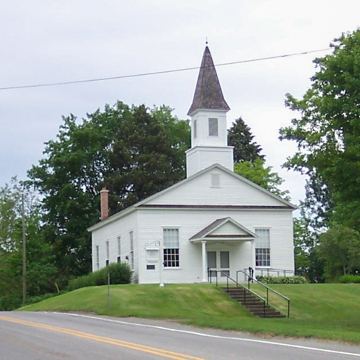You are here
Omena Presbyterian Church (Grove Hill New Mission Church)
The steepled white wood-frame church is in the simplified New England tradition. The interior is arranged with two side aisles separating three banks of pews. Twelve-over-twelve windows, four on each side and two on the front, admit ample light to the sanctuary. The Reverend Peter Dougherty (1805–1894), a graduate of Princeton Theological Seminary and a Presbyterian missionary, arrived in the Grand Traverse area in 1838. He organized a Protestant mission for Native Americans at present-day Old Mission in 1843, putting up his one-and-a-half-story, side-gable, post-and-beam wooden house (Peter Dougherty Historic Homesite; 18459 Mission Road, Peninsula Township, Grand Traverse County) in 1842. He moved the mission west across Grand Traverse Bay in 1852 and built the New Mission Church on the high bluff east of Omena. The work of the mission continued until about 1870, when the boarding school was abandoned, and the church was placed under the Presbytery. Today the church holds services only during the summer.
Writing Credits
If SAH Archipedia has been useful to you, please consider supporting it.
SAH Archipedia tells the story of the United States through its buildings, landscapes, and cities. This freely available resource empowers the public with authoritative knowledge that deepens their understanding and appreciation of the built environment. But the Society of Architectural Historians, which created SAH Archipedia with University of Virginia Press, needs your support to maintain the high-caliber research, writing, photography, cartography, editing, design, and programming that make SAH Archipedia a trusted online resource available to all who value the history of place, heritage tourism, and learning.











